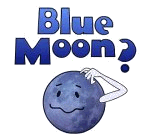 Tomorrow night, when the full moon rises over North America, it is believed that this will be a “blue moon.” The modern definition for “blue moon” is the second full moon to occur within a calendar month and tomorrow’s full moon will indeed be the second to occur in the month of May, 2007.
Tomorrow night, when the full moon rises over North America, it is believed that this will be a “blue moon.” The modern definition for “blue moon” is the second full moon to occur within a calendar month and tomorrow’s full moon will indeed be the second to occur in the month of May, 2007.
Cartoon Image courtesy of NASA.
But hold on – Sky and Telescope magazine retracted it’s 1946 second-in-a-month definition in favor of stating that the “blue moon” is actually based on the four seasons and is the fourth full moon to occur within a season (Winter, Spring, Summer and Autumn). Using this definition, a “blue moon” may or may not occur within a calendar month.
It gets even more confusing.
From Science@NASA
At 9:04 pm Eastern Daylight Time on May 31st, the full moon over North America will turn blue.
Not really. But it will be the second full moon of May and, according to folklore, that makes it a Blue Moon.
If you told a person in Shakespeare’s day that something happens “once in a Blue Moon” they would attach no astronomical meaning to the statement. Blue moon simply meant rare or absurd, like making a date for “the Twelfth of Never.”
But “meaning is a slippery substance,” writes Philip Hiscock of the Dept. of Folklore, Memorial University of Newfoundland. “The phrase ‘Blue Moon’ has been around a long time, well over 400 years, and during that time its meaning has shifted.”
Blue Moon?The modern definition sprang up in the 1940s. In those days the Maine Farmer’s Almanac offered a definition of Blue Moon so convoluted even professional astronomers struggled to understand it. It involved factors such as ecclesiastical dates of Easter and Lent, tropical years, and the timing of seasons according to the dynamical mean sun. Aiming to explain blue moons to the layman, Sky & Telescope published an article in 1946 entitled “Once in a Blue Moon.” The author James Hugh Pruett (1886-1955) cited the 1937 Maine almanac and opined that the “second [full moon] in a month, so I interpret it, is called Blue Moon.”
This was not correct, but at least it could be understood. And thus the modern Blue Moon was born. A detailed account of the story may be found here.
Surveying the last four centuries of literature and folklore, “I have counted six different meanings which have been carried by the term,” recounts Hiscock. In song, for instance, Blue Moons are a symbol of loneliness; when love conquers all, the Blue Moon turns gold. (See old Elvis records for more information.) “This makes discussion of the term a little complicated,” he says.

We tried to photograph it as the moon appears clearer to us due to the lack of ambient lighting here. The sandstorm and rockets changed our minds. We will be able to at least see the full moon tomorrow, provided the weather cooporates and Hajji takes a few hours off. Take care
co.co . . .
Here along the coastline in Southern California at this time of year, we have a marine inversion layer where stratus clouds often form and obscure the sky. We may or may not see the Moon tomorrow night depending on conditions. However, we’ll take that to sandstorms and rockets any time.
Tell your comrades that we think about you guys often and hope that you stay safe.